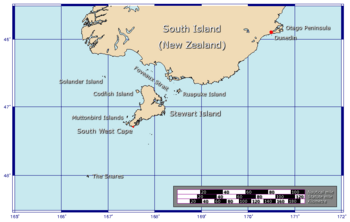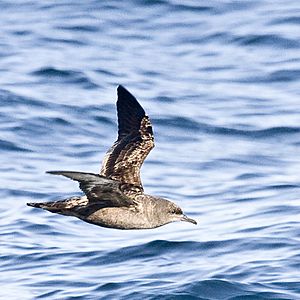Taukihepa / Big South Cape Island facts for kids

Big South Cape Island is the largest of the islands marked on this map as "Muttonbird Islands" to the southwest of Stewart Island/Rakiura
|
|
| Geography | |
|---|---|
| Location | South Tasman Sea, southwest of Stewart Island/Rakiura |
| Coordinates | 47°14′23″S 167°24′02″E / 47.2398°S 167.4006°E |
| Archipelago | New Zealand archipelago |
| Area | 9 km2 (3.5 sq mi) |
| Length | 5.5 km (3.42 mi) |
| Width | 2.5 km (1.55 mi) |
| Highest elevation | 235 m (771 ft) |
| Administration | |
| Regional Council | Southland |
Big South Cape Island, also known as Taukihepa, is a special island off the coast of New Zealand. It's located southwest of Stewart Island/Rakiura. No one lives on the island all year round. However, people called "muttonbirders" visit it to catch a type of bird called the sooty shearwater. These birds are often called "muttonbirds" in New Zealand.
The Māori people originally named the island "Taukihepa." Later, European settlers arrived and called it "Big South Cape." In 2001, the island was officially given both names. This was part of an agreement with the Ngāi Tahu Māori tribe, known as a Treaty of Waitangi settlement.
Taukihepa is the biggest island in a group of islands near Stewart Island/Rakiura. A channel about 1,500-metre (4,921 ft) wide separates it from Stewart Island. Other smaller islands nearby include Poutama Island to the south and Putauhina Island to the northwest. The island's highest point is 235 metres (771 ft) tall. Many small streams flow down to the coast. The island covers an area of about 900 hectares (2,200 acres).
The Rat Invasion of Taukihepa
For a long time, Māori muttonbirders visited Taukihepa every summer. They came to hunt sooty shearwaters, which nested on the island each spring. But in March 1964, the muttonbirders found something terrible. Rats had taken over the island. This caused one of New Zealand's biggest environmental problems of the 20th century.
Before this, Taukihepa had no mammals that hunted other animals. The arrival of rats quickly destroyed the island's natural balance. Many unique birds, some of which could not fly, became extinct in just a few years. The number of insects and birds that survived was greatly reduced.
Saving the Island from Rats
To fix this problem, a special program was started to get rid of the rats. This program worked, and by 2006, the island was free of rats again. This was a huge step in helping the island's environment recover.
Animals That Disappeared
Even with help from the New Zealand Wildlife Service, some animals could not be saved. The Wildlife Service tried to move some birds to other islands that had no rats. However, two bird species did not survive and became extinct. These were the Stead's bush wren and the South Island snipe. The New Zealand greater short-tailed bat also sadly became extinct.


